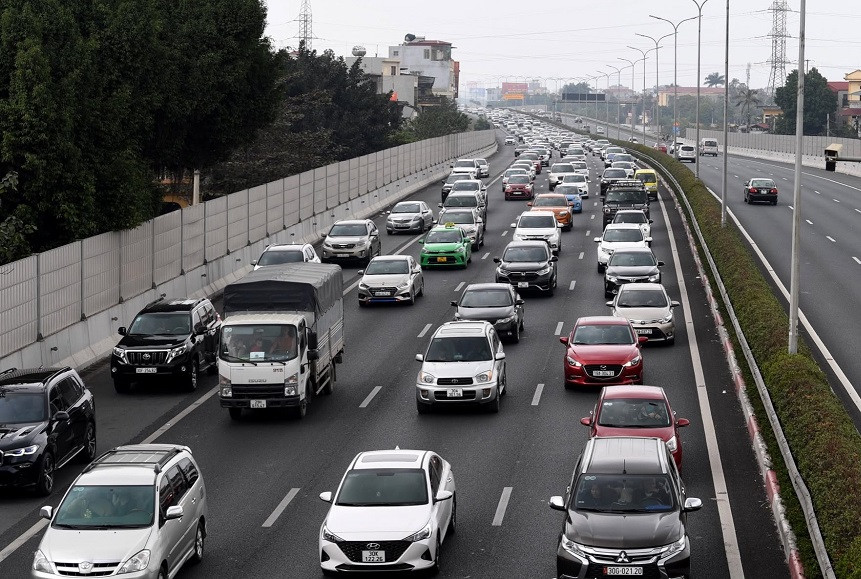Vietnamese businesses are voicing concerns that a new emissions roadmap could lead to the early retirement of vehicles produced from 2022, particularly those meeting Euro 4 standards, creating significant waste after only a few years in use.

According to the draft regulation outlining Vietnam’s plan to adopt automotive emissions standards, vehicle emissions are categorized into five levels based on Euro standards. Among them, level 5 represents the most stringent technical requirements.
The proposed schedule states that from January 1, 2026, vehicles manufactured from 2022 onward must meet at least level 4 emissions standards. For vehicles registered in Hanoi and Ho Chi Minh City, the requirement will rise to level 5 from January 1, 2027. Other provinces and cities will follow with level 5 enforcement beginning in 2028.
At a consultation session held on June 3 regarding the draft emissions regulation for in-use vehicles, many representatives from the automobile manufacturing and assembly sector raised doubts about the feasibility of the policy and proposed revisions to the implementation schedule to align more closely with on-the-ground conditions.
Proposals to adjust fuel standards and implementation timeline
Tran Kim Chi, representing Ford Vietnam and a member of the Vietnam Automobile Manufacturers Association (VAMA), acknowledged the drafting committee’s efforts to promote emissions control. However, she emphasized the need to address a more fundamental issue: the standards for fuel quality.
“If emissions standards are tightened without ensuring compatible fuel supply, it will be extremely difficult for businesses to comply, and consumers will struggle to access new vehicles,” said Chi.
The Ford representative highlighted the paradox in the current regulations, where newer vehicles with advanced technology might be phased out due to noncompliance, while older models with inferior technology continue operating legally.
Sharing a similar view, a representative from Mitsubishi Motors Vietnam raised concerns about the availability of fuel that meets level 5 emission standards.
"At present, only Hanoi and Ho Chi Minh City have access to level 5 fuel. Other regions barely have it," said Oanh, a representative from the company.
Mitsubishi also expressed concern that requiring vehicles manufactured from 2022 to comply with level 5 standards by 2030 would result in many Euro 4 vehicles being phased out prematurely, leading to avoidable waste. “Why are level 4 vehicles, which are significantly cleaner, being eliminated while level 1 and 2 vehicles are still allowed on the road?” Oanh questioned.
Emissions control must go hand in hand with clean fuel supply
According to the Vietnam Register, emissions standards for manufactured, assembled, and imported vehicles have been gradually legislated in line with European benchmarks. Specifically, Euro 2 was applied in 2007, Euro 4 in 2017, and Euro 5 in 2022. However, the implementation has not been uniform due to transition policies allowing older-standard vehicles to remain in circulation.
Addressing the shortage of Euro 5-compliant fuel, particularly the limited availability of clean diesel in many localities, Tran Hoang Phong from the Vietnam Register warned that using incompatible fuel can trigger engine errors, major repairs, or require downgrading of engines -potentially increasing emissions beyond acceptable levels.
Do Minh Quan from the Domestic Market Management Department under the Ministry of Industry and Trade stated that the ministry is working with relevant agencies to ensure the market’s fuel supply meets national technical standards for gasoline, diesel, and biofuels.
Regarding the timeline for applying new emissions standards, Quan noted that while most of the current fuel supply only meets level 3 standards, the draft regulation mandates levels 4 and 5. As such, the Ministry of Industry and Trade will continue collaborating with other ministries to align fuel supply with regulatory requirements.
After discussions with leading fuel suppliers, Quan assessed that providing level 3, 4, and 5 standard fuels is achievable. However, he emphasized the necessity of a clear roadmap, allowing businesses time to upgrade infrastructure and equipment to meet higher fuel quality standards in the near future.
Vu Diep